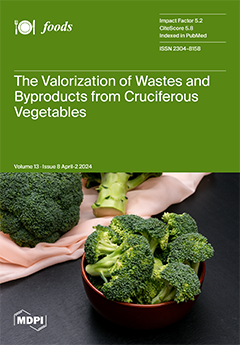Spirulina, a cyanobacterium widely used as a food supplement due to its high nutrient value, contains volatile organic compounds (VOCs). It is crucial to assess the presence of VOCs in commercial spirulina products, as they could influence sensory quality, various processes, and technological
[...] Read more.
Spirulina, a cyanobacterium widely used as a food supplement due to its high nutrient value, contains volatile organic compounds (VOCs). It is crucial to assess the presence of VOCs in commercial spirulina products, as they could influence sensory quality, various processes, and technological aspects. In this study, the volatile profiles of seventeen commercial spirulina food supplements were determined using headspace solid-phase microextraction (HS-SPME), coupled with gas chromatography-mass spectrometry (GC-MS). The identification of volatile compounds was achieved using a workflow that combined data processing with software tools and reference databases, as well as retention indices (RI) and elution order data. A total of 128 VOCs were identified as belonging to chemical groups of alkanes (47.2%), ketones (25.7%), aldehydes (10.9%), alcohols (8.4%), furans (3.7%), alkenes (1.8%), esters (1.1%), pyrazines (0.8%), and other compounds (0.4%). Major volatiles among all samples were hydrocarbons, especially heptadecane and heptadec-8-ene, followed by ketones (i.e., 4-(2,6,6-trimethyl-1-cyclohexen-1-yl)-3-buten-2-one, β-ionone, 2,2,6-trimethylcyclohexan-1-one), aldehydes (i.e., hexanal), and the alcohol oct-1-en-3-ol. Several volatiles were found in spirulina dietary supplements for the first time, including 6,10-dimethylundeca-5,9-dien-2-one (geranylacetone), 6,10,14-trimethylpentadecan-2-one, hept-2-enal, octanal, nonanal, oct-2-en-1-ol, heptan-1-ol, nonan-1-ol, tetradec-9-en-1-ol, 4,4-dimethylcyclohex-2-en-1-ol, 2,6-diethylpyrazine, and 1-(2,5-dimethylfuran-3-yl) ethanone. The methodology used for VOC analysis ensured high accuracy, reliability, and confidence in compound identification. Results reveal a wide variety of volatiles in commercial spirulina products, with numerous newly discovered compounds, prompting further research on sensory quality and production methods.
Full article






